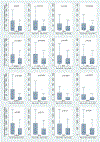Contributions of nearby agricultural insecticide applications to indoor residential exposures
- PMID: 36493610
- PMCID: PMC10038187
- DOI: 10.1016/j.envint.2022.107657
Contributions of nearby agricultural insecticide applications to indoor residential exposures
Abstract
Background: Pesticide exposure has been associated with adverse health effects. We evaluated relationships between proximity to agricultural insecticide applications and insecticides in household dust, accounting for land use and wind direction.
Methods: We measured concentrations (ng/g) of nine insecticides in carpet-dust samples collected from 598 California homes. Using a geographic information system (GIS), we integrated the California Pesticide Use Reporting (CPUR) database to estimate agricultural use within residential buffers with radii of 0.5 to 4 km. We calculated the density of use (kg/km2) during 30-, 60-, 180-, and 365-day periods prior to dust collection and evaluated relationships between three density metrics (CPUR unit-based, agricultural land area adjusted, and average daily wind direction adjusted) and dust concentrations. We modeled natural-log transformed concentrations using Tobit regression for carbaryl, chlorpyrifos, cypermethrin, diazinon, and permethrin. Odds of detection were modeled with logistic regression for azinphos-methyl, cyfluthrin, malathion, and phosmet. We adjusted for season, year, occupation, and home/garden uses.
Results: Chlorpyrifos use within 1-4 km was associated with 1 to 2-times higher dust concentrations in both the 60- and 365-day periods. Carbaryl applications within 2-4 km of homes 60-days prior to dust collection were associated with 3 to 7-times higher concentrations and the 4 km trend was strongest using the wind-adjusted metric (p-trend = 0.04). For diazinon, there were 2-times higher concentrations for the 60-day metrics in the 2 km buffer and for the CPUR and wind-adjusted metrics within 4 km. Cyfluthrin, phosmet, and azinphos-methyl applications within 4 km in the prior 365-days were associated with 2-, 6-, and 3-fold higher odds of detection, respectively.
Conclusions: Agricultural use of six of the nine insecticides within 4 km is an important determinant of indoor contamination. Our findings demonstrated that GIS-based metrics for quantifying potential exposure to fugitive emissions from agriculture should incorporate tailored distances and time periods and support wind-adjustment for some, but not all insecticides.
Keywords: Environmental epidemiology, Dust, Agriculture; Exposure assessment; Insecticides; Pesticides.
Published by Elsevier Ltd.
Conflict of interest statement
Declaration of Competing Interest The authors declare that they have no known competing financial interests or personal relationships that could have appeared to influence the work reported in this paper.
Figures




References
-
- Atwood D; Paisley-Jones C.Pesticides Industry Sales and Usage: 2008 and 2012 Market Estimates.: United States Environmental Protection Agency; 2017
-
- Bennett DH; McKone TE; Matthies M; Kastenberg WE General formulation of characteristic travel distance for semivolatile organic chemicals in a multimedia environment. Environmental Science and Technology 1998;32:4023–4030
-
- Bigelow DP; Borchers A.Major Uses of Land in the United States, 2012,. EIB-178: U.S. Department of Agriculture, Economic Research Service, ; 2017
-
- Brouwer M; Huss A; van der Mark M; Nijssen PCG; Mulleners WM; Sas AMG; van Laar T; de Snoo GR; Kromhout H; Vermeulen RCH Environmental exposure to pesticides and the risk of Parkinson’s disease in the Netherlands. Environment international 2017;107:100–110 - PubMed

